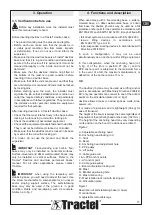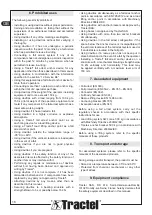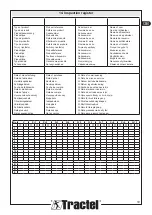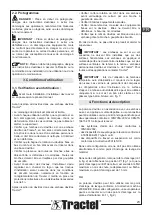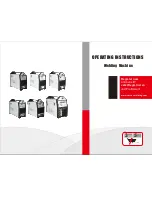
11
GB
3. Operation
3.1. Verification before use
Before any installation work, the installer must
have this manual ready to hand.
Before inserting davitrac in a Tractel
®
davitrac base:
•
The product marking must be present and legible.
•
Before each use, make sure that the product is in
a visibly good condition, free from marks, impacts
or deformation. If not, do not use it and inform the
supervisor.
•
Make sure that the davitrac base is a Tractel
®
davitrac
base and that it is in good condition and adequately
secured to the structure if it is permanent. It must be
cleaned thoroughly on the inside and must not be
deformed.
•
Make sure that the davitrac rotation ring fitted at
the bottom of the mast is in good condition before
inserting it into a davitrac base.
•
Make sure that all the rods are present, and that they
are not deformed or corroded. All rods must be locked
by locking pins.
•
Before starting upon the work, the installer must
organise the job so that installation work is carried out
under the required safety conditions, and particularly
in accordance with labour regulations. They must use
the collective and/or personal protective equipment
required for that purpose.
After inserting davitrac in a Tractel
®
davitrac base:
•
Check that the mast rotates freely in the base before
locking it in place using a rod with a locking pin.
•
Check the condition of associated equipment.
•
Check all the equipment brackets fastened to davitrac:
They must not be deformed, cracked or corroded.
•
Make sure that the davitrac mast is locked in its base
by means of the rod with a locking pin.
If in doubt, do not use the product and inform the
supervisor.
IMPORTANT
: Floor-standing and built-in floor
bases may only be installed on horizontal surfaces.
Surface-mounted and offset wall-mounted bases may
only be installed on vertical surfaces. Refer to the
Tractel
®
“davitrac and davimast permanent bases”
manual. For all other applications, please contact
Tractel
®
.
IMPORTANT
: when using the temporary self-
stabilising base, you will need to adjust the level. Use
the screw mechanisms to compensate for an uneven
and/or sloping support surface. The self-stabilising
base may only be used if the ground is in good
condition, stable and non-slipping such as concrete,
bitumen, etc. fig. 7.
4. Functions and description
When used along with a floor-standing base, a surface-
mounted base, an offset wall-mounted base or built-in
floor base, the davitrac jib crane may be used as a fall
protection anchor point for two operators in accordance with
EN 795A:2012 and CEN/TS 16415:2013, it may be fitted with
•
fall arrest systems in accordance with EN 363:2002,
•
rescue lifting devices in accordance with
EN 1496:2017 type A or B,
•
rope-suspended working devices in accordance with
Directive 2001/45/EC.
In such a configuration, it may not be used
simultaneously as an anchor point for lifting equipment.
In this configuration, when the anchoring head (ref.
A, fig. 2) of the jib is in position P1 (fig. 1) and its
PPE anchor point is subjected to the maximum force
in the event of a fall, the maximum displacement, or
deflection, of the anchor point is 15 mm.
OR
The davitrac jib crane may be used as a lifting anchor
point in accordance with Machinery Directive 2006/42/
EC; only one operator can connect to one of the anchor
points on the articulation plate (ref. I2, fig 2)
davitrac allows access to narrow spaces, wells, silos,
sewers, etc.
It is made of aluminium and is lightweight (30 kg) for
ease of transport.
The height of the boom is always the same regardless of
the position of the anchoring head on the boom (1921 mm).
The height of the anchoring head may vary depending
on its position on the boom (3 positions see table 1).
Figure 2:
A - Adjustable anchoring head
B - Anchoring head locking rod
C - Strut
D - Boom
E - Anchoring head adjustment hole
F - PPE pulley
G - Lift pulley
H - Cable guide rod
I
1
& I
2
-PPE anchor points
J - Lift anchor point
K - Cable guide pulley
L - Boom articulation locking rod
M - Mast
N - Bracket positioning hole
O - Mast rotation ring
P - Mast rotation lock rod with locking pin
Q - Articulation plate
Figure 1
Description of self-stabilising base (U base)
R: central base
S: adjustable removable legs











